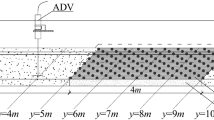Abstract
In this study, thermally driven flow within a sharp change of rooted emergent vegetation distributions is discussed. A conceptual and linear model is developed to study the interferences and competitions between two forcing mechanisms (vegetation shading and sloping bottom effects) on circulation patterns. The two forcing mechanisms can counteract or reinforce each other according to the presence of emergent vegetation in shallow or deep regions. For tall vegetation in shallows and open water in deep regions, vegetation shading leads to opposite temperature gradients against those from a slope. A critical vegetation blockage \(B_{\textit{critical}}\) is found to cause a minimum horizontal exchange flowrate and divide the flow regime as topographic or vegetation shading dominated. In clear water, opposite circulation from the bottom is produced and gradually spreads to the whole water column. On the contrary, in turbid water, the opposite circulation emerges from the water surface and gradually propagates to the sloping bottom. The circulation in turbid water is more easily affected by a sharp change of vegetation distributions rather than clear water. For open in shallows and tall vegetation in deep water, pressure gradients from vegetation shading can enhance buoyancy from the sloping bottom and lead to greater horizontal exchange flowrates. Due to a sharp change of emergent vegetation distributions, horizontal exchange flowrates are possibly increased and greater than those without vegetation. In short, circulation patterns and strength can be significantly affected by a sharp change of emergent vegetation distributions.













Similar content being viewed by others
References
James WF, Barko J (2001) Estimation of phosphorous exchange between littoral and pelagic zoned during nighttime convective circulation. Limnol Oceanog 36(1):179–187
Zhang X, Nepf HM (2009) Thermally driven exchange flow between open water and an aquatic canopy. J Fluid Mech 632:227–243. doi:10.1017/s0022112009006491
Coates M, Ferris J (1994) The radiatively driven natural convection beneath a floating plant layer. Limnol Oceanogr 39:1186–1194
Coates M, Patterson JJ (1993) Unsteady natural convection in a cavity with non-uniform absorption of radiation. J Fluid Mech 256:133–161
Farrow DE, Patterson JC (1993) On the response of a reservoir sidearm to diurnal heating and cooling. J Fluid Mech 246:143–161
Lightbody A, Avener M, Nepf H (2008) Observations of short-circuiting flow paths within a free-surface wetland in Augusta, Georgia. Limnol Oceangr 53(3):1040–1053
Ultsch G (1973) The effect of water hyacinth ( Eichhornia crassipes) on the microenvironment of aquatic communities. Arch Hydrobiol 72:460–473
Lövstedt CB, Bengtsson L (2008) Density-driven current between reed belts and open water in a shallow lake. Water Resour Res 44(W10413), doi:10.1029/2008WR006949
Zhang X, Nepf HM (2008) Density driven exchange flow between open water and an aquatic canopy. Water Resour Res 44(W08417), doi:10.1029/2007WR006676
Zhang X, Nepf HM (2011) Exchange flow between open water and floating vegetation. Environ Fluid Mech 11(5):531–546. doi:10.1007/s10652-011-9213-4
Monismith SG, Imberger J, Morison ML (1990) Convective motion in the sidearm of a small reservoir. Limnol Oceanogr 35:1676–1702
Farrow DE, Patterson JC (1994) The daytime circulation and temperature pattern in a reservoir sidearm. Int J Heat Mass Transfer 37:1957–1968
Adams EE, Wells SA (1984) Field measurements on side arms of Lake Anna Va. J Hydraul Engng 110:773–793
Farrow DE (2004) Periodically forced natural convection over slowly varying topography. J Fluid Mech 508:1–21
Lei C, Patterson JC (2002) Unsteady natural convection in a triangular enclosure induced by absorption of radiation. J Fluid Mech 460:181–209
Lei C, Patterson JC (2006) Natural convection induced by diurnal heating and cooling in a reservoir with slowly varying topography. JSME Int J Ser B: Fluids and Thermal Engineering 49(3):605–615
Bednarz TP, Lei C, Patterson JC (2009) Unsteady natural convection induced by diurnal temperature changes in a reservoir with slowly varying bottom topography. Int J Ther Sci 48:1932–1942
Wietzel RG (2001) Limnology, 3rd edn. Academic Press
Lin YT, Wu CH (2014) The role of rooted emergent vegetation on periodically thermal-driven flow over a sloping bottom. Environ Fluid Mech doi:10.1007/s10652-014-9336-5
Pokorny J, Kvet J (2004) Aquatic plants and lake ecosystem. In: O’Sullivan PE, Reynolds CS (eds) The lakes handbook, vol 1. Blackwell, Oxford, pp 309–340
Tanino Y, Neph HM, Kulis PS (2005) Gravity current in aquatic canopies. Water Resour Res 41(W12402), doi:10.1029/2005WR004216
Jamali M, Zhang X, Nepf HM (2008) Exchange flow between a canopy and open water. J Fluid Mech 611:237–254. doi:10.1017/S0022112008002796
Poulikakos D, Bejan A (1983) The fluid dynamics of an attic space. J Fluid Mech 131:251–269
Farrow DE (1991) Unsteady Natural convection in reservoir sidearms. Ph.D thesis. University of Western Australia
Koch EW (2001) Beyond light: physical, geological and geochemical parameters as possible submersed aquatic vegetation habitat requirements. Estuaries 24(1):1–17
Horsh GM, Stefan HG (1988) Convective circulation in littoral water due to surface cooling. Limnol Oceanogr 33(5):1068–1083
Farrow DE (2013) Periodically driven circulation near the shore of a lake. Envrion Fluid Mech 13(3):243–255. doi:10.1007/s10652-012-9261-4
Lin, Y.T. (2014) Wind effect on diurnal thermally driven flow in vegetated nearshore of a lake. Environ Fluid Mech. doi:10.1007/s10652-014-9368-x
Acknowledgments
The authors would like to thank funding support from the National Chiao-Tung University of Taiwan and National Science Council of Taiwan through grants NSC 102-2218-E-009-005. The authors thank two anonymous reviewers and Dr. H.J.S. Fernando, Editor-in-Chief, for their helpful comments and suggestions for improvement of the paper.
Author information
Authors and Affiliations
Corresponding author
Electronic supplementary material
Below is the link to the electronic supplementary material.
Rights and permissions
About this article
Cite this article
Lin, YT., Wu, C.H. Effects of a sharp change of emergent vegetation distributions on thermally driven flow over a slope. Environ Fluid Mech 15, 771–791 (2015). https://doi.org/10.1007/s10652-014-9382-z
Received:
Accepted:
Published:
Issue Date:
DOI: https://doi.org/10.1007/s10652-014-9382-z




